Abstract
1. Studies have been made of the contractile responses to the alpha-adrenoceptor agonists phenylephrine (Phen), cirazoline (Cir) or BHT-920 (BHT) in dog isolated saphenous vein (DSV) rings, using the antagonists yohimbine (Yoh), idazoxan (Idaz), prazosin (Praz), WB-4101 (WB) and nitrendipine or zero Ca2+ medium. 2. Contractile concentration-response curves to Phen or BHT were displaced to the right of controls by Yoh (0.01-3 microM) with mean apparent antagonist dissociation constants (pKBs) of 7.9 and 8.6 respectively. Yoh did not show simple competitive antagonism against either agonist, since the Schild plot slopes were significantly less than unity. Neither the antagonist affinity of Yoh against Phen, nor the slope of the Schild plot was modified in the presence of catecholamine uptake inhibitors, nor in the presence of alpha,beta-methylene ATP, which desensitizes P2-purinoceptors, suggesting that Phen does not release ATP, or noradrenaline to cause contraction in DSV. In the presence of Praz (0.3 microM) the antagonist potency of Yoh (mean pKB 7.4) against Phen was slightly decreased. Yoh had low potency against responses induced by Cir (pKB 6.3). 3. WB (0.001-1.0 microM) was a very potent antagonist of Phen-induced contractions, however, the biphasic Schild plot against Phen could be separated into two affinity sites, a high pKB of 9.3 (equivalent to that obtained using Cir as the agonist; pKB 9.6) and a lower affinity (pKB 8.6). WB showed an even lower antagonist affinity (pKB 7.4) against BHT-induced contractions, suggesting that these effects might be mediated by alpha 2A-adrenoceptors. Praz also appeared to identify two sites using Phen-induced contractions, a high pKB of 8.4 was equivalent to that obtained with Cir (pKB 8.2) and a lower affinity site (pKB 7.7; pA2 7.6; slope 1.1) at which Praz showed competitive antagonism. Higher concentrations of Praz were required to antagonize contractions to BHT (pKB 5.9). 4. Idaz was a weak partial agonist in this tissue with threshold contractile effects at concentrations in excess of 3 microM. Idaz (0.1-1 microM) competitively antagonized the contractile effects of BHT, but showed low antagonist affinity against Phen at these concentrations. 5. Contractions to Phen were slightly antagonized by nitrendipine (1 microM), with a 36% decrease in Emax. Contractions to Phen and Cir were also markedly attenuated in zero calcium medium (with EGTA), but maximum responses of 4.2 +/- 0.1 and 3.6 +/- 0.1 g, could be obtained with these agonists respectively.(ABSTRACT TRUNCATED AT 400 WORDS)
Full text
PDF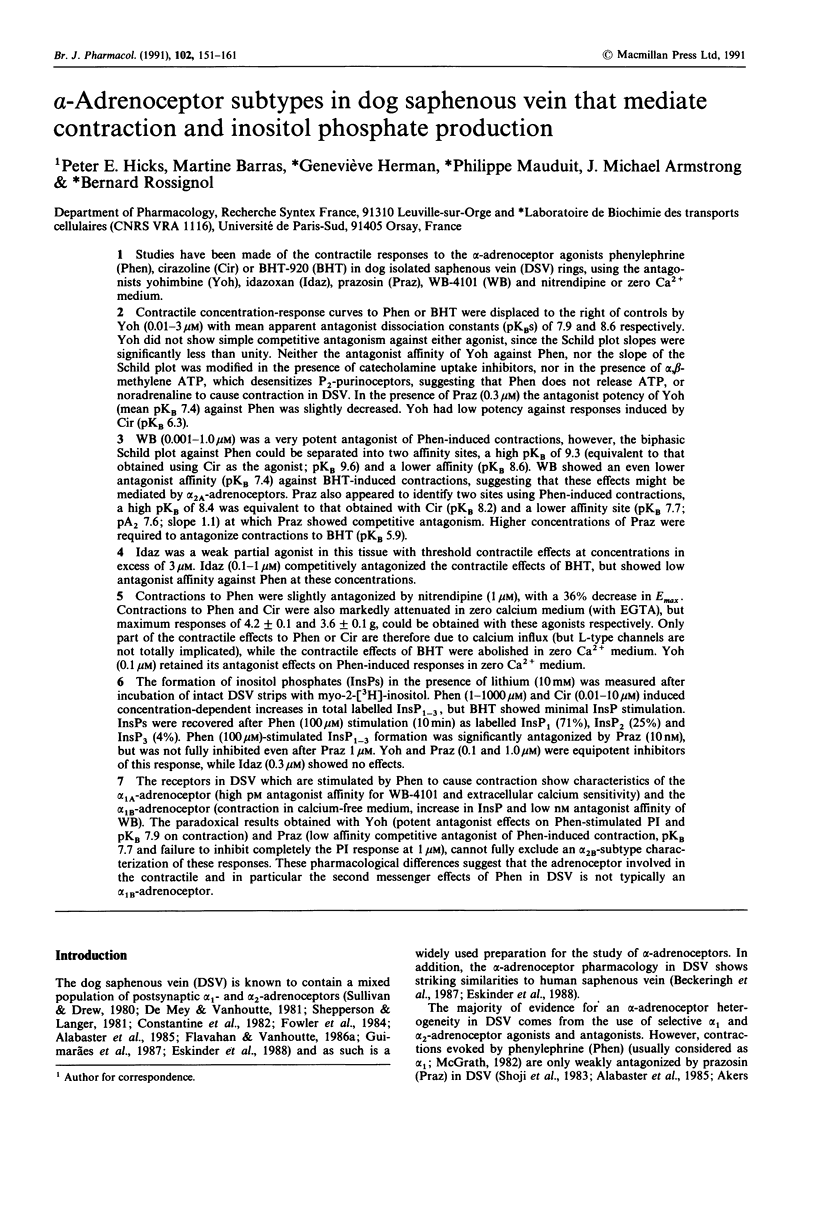
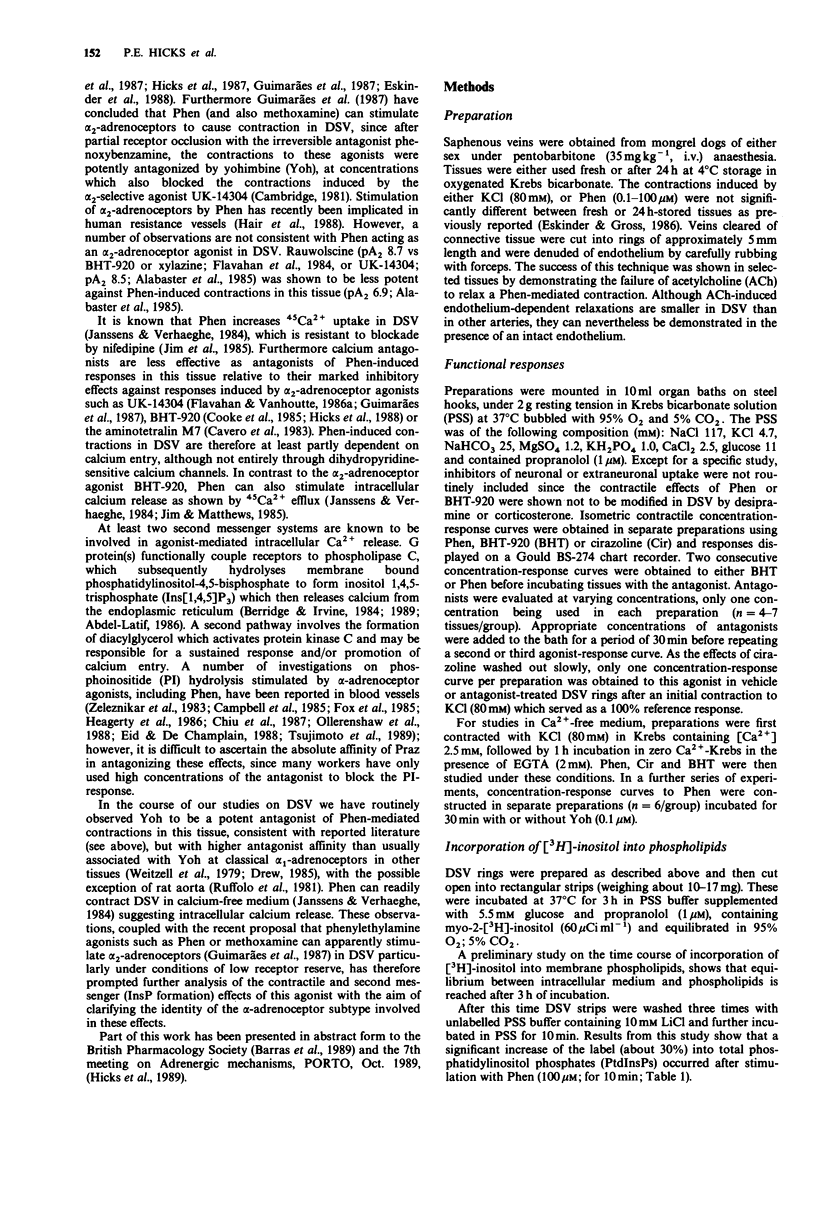
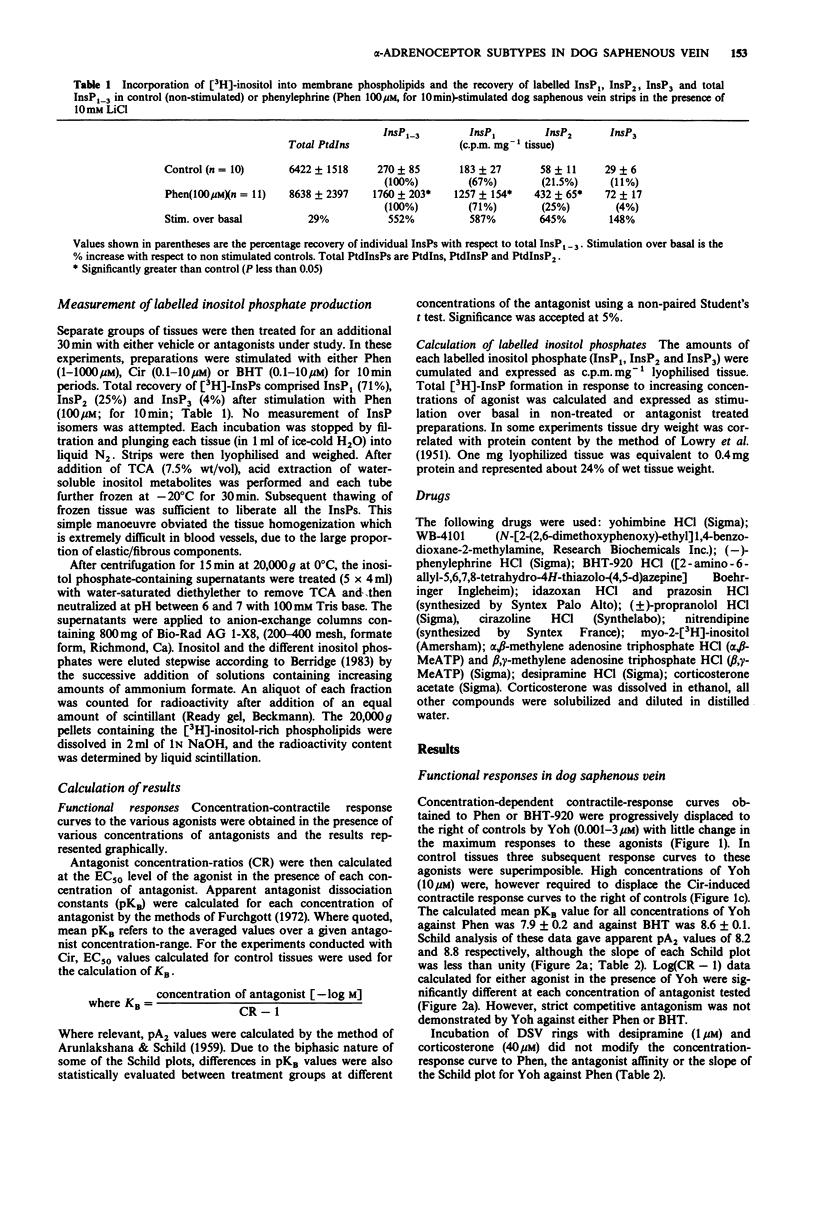
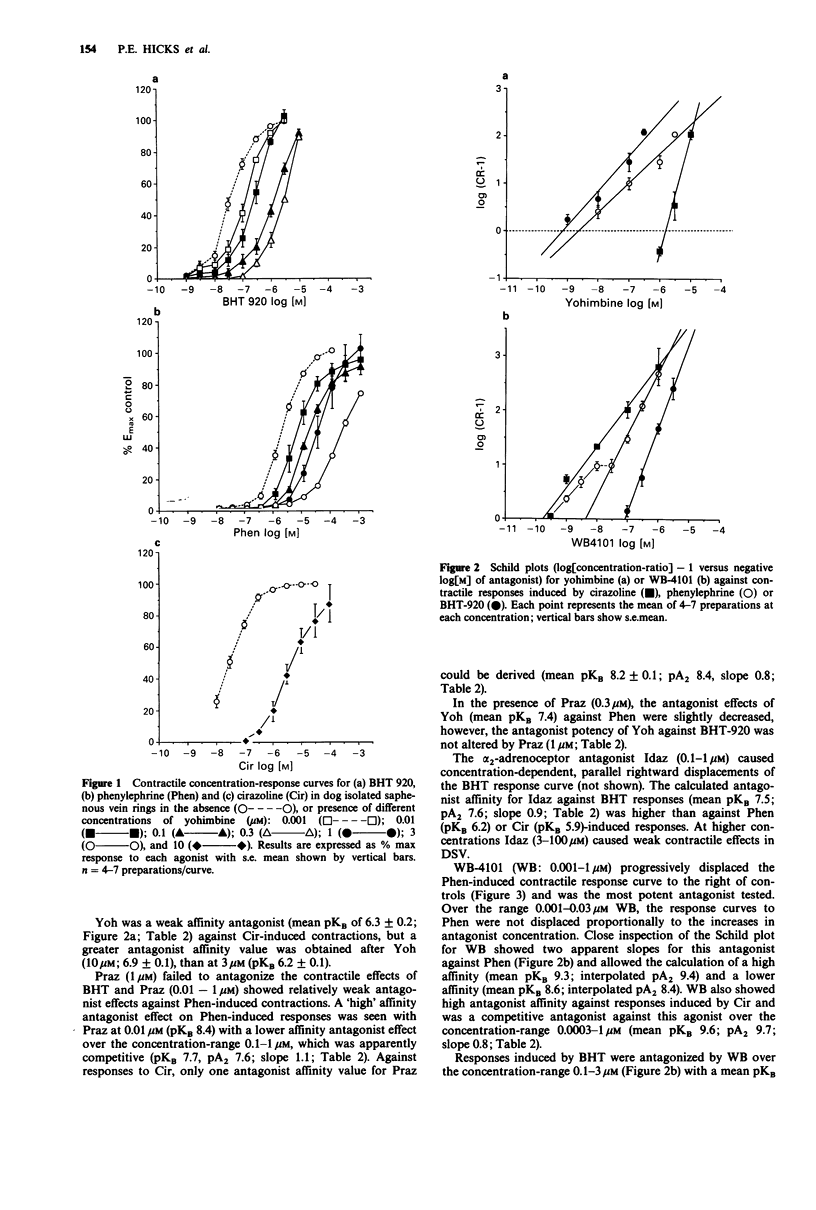
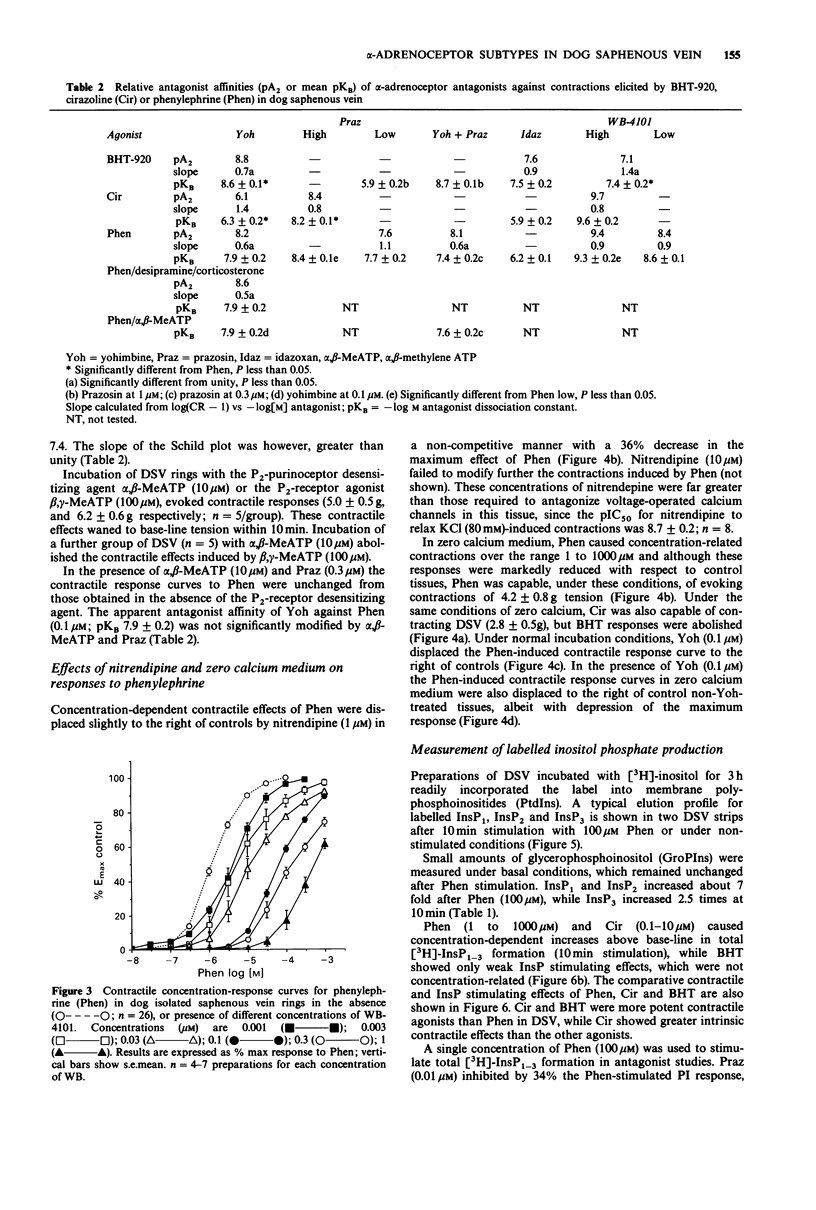
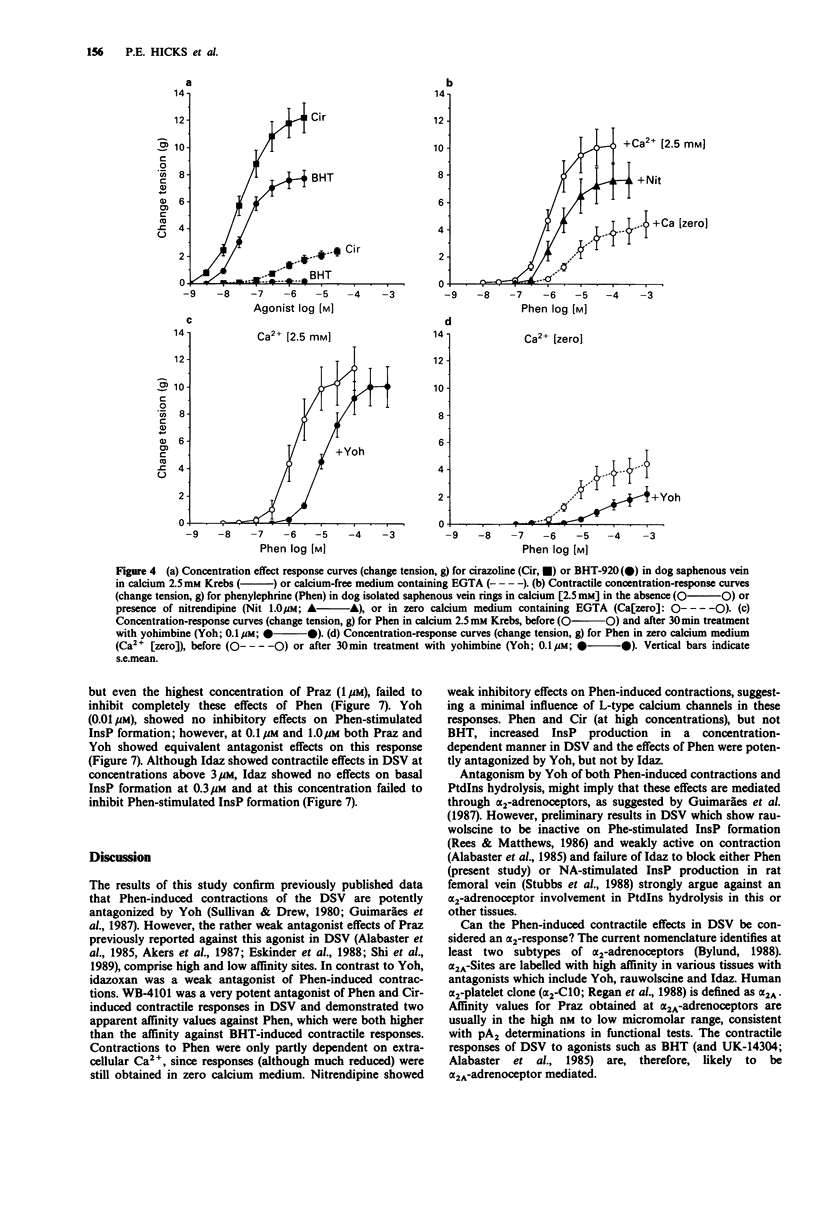
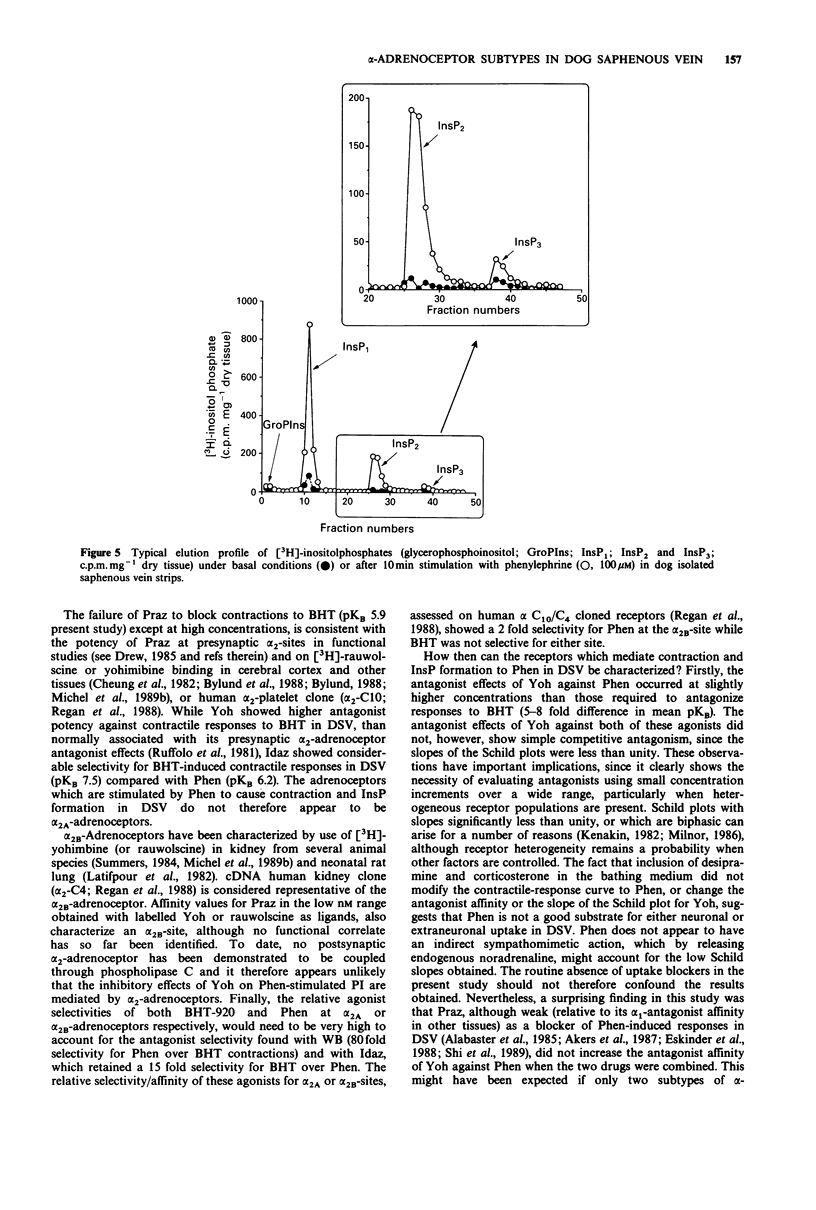
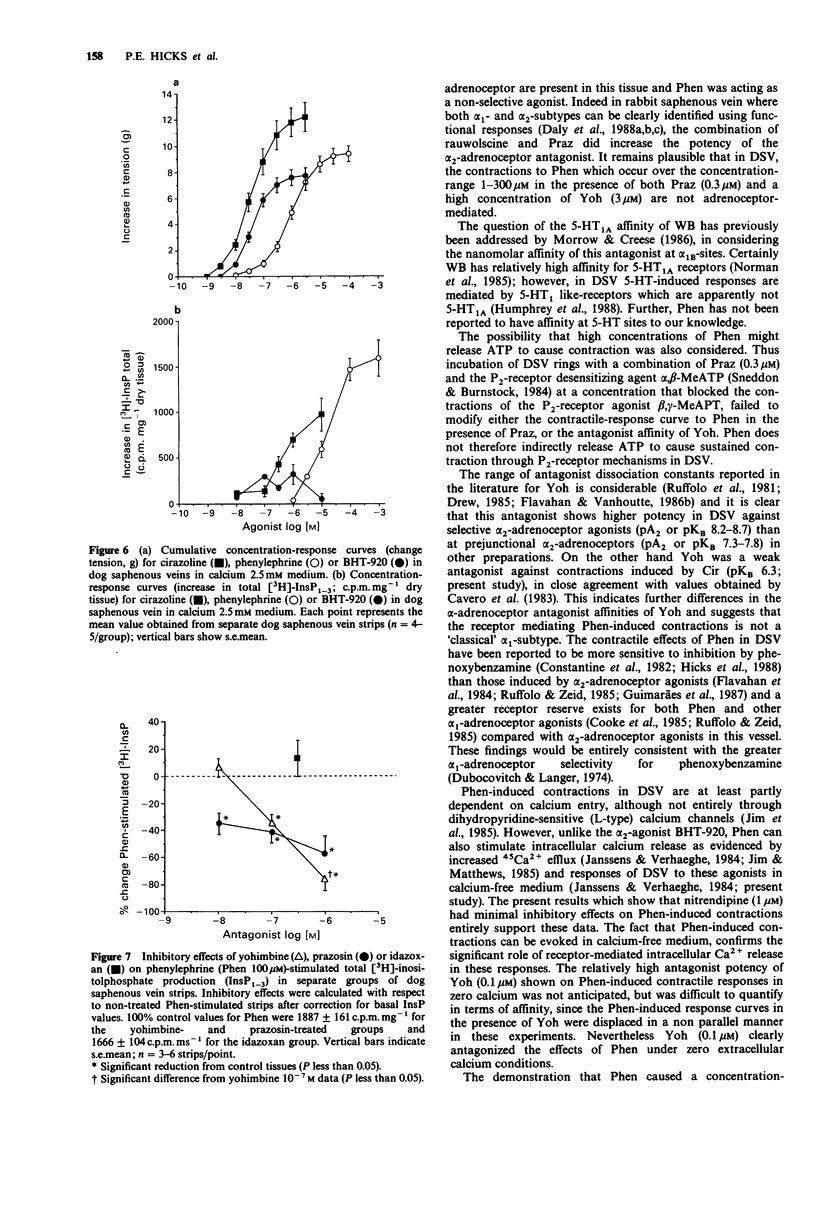
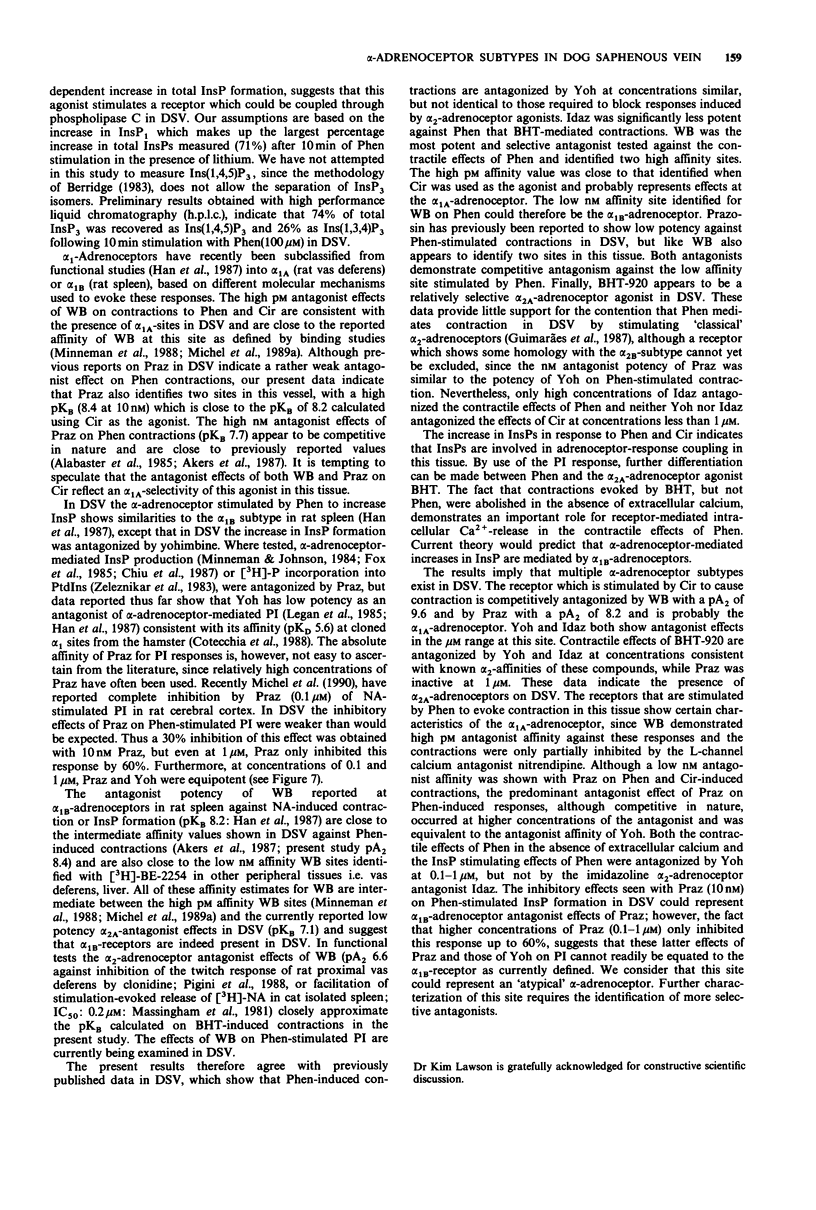


Selected References
These references are in PubMed. This may not be the complete list of references from this article.
- ARUNLAKSHANA O., SCHILD H. O. Some quantitative uses of drug antagonists. Br J Pharmacol Chemother. 1959 Mar;14(1):48–58. doi: 10.1111/j.1476-5381.1959.tb00928.x. [DOI] [PMC free article] [PubMed] [Google Scholar]
- Abdel-Latif A. A. Calcium-mobilizing receptors, polyphosphoinositides, and the generation of second messengers. Pharmacol Rev. 1986 Sep;38(3):227–272. [PubMed] [Google Scholar]
- Alabaster V. A., Keir R. F., Peters C. J. Comparison of activity of alpha-adrenoceptor agonists and antagonists in dog and rabbit saphenous vein. Naunyn Schmiedebergs Arch Pharmacol. 1985 Jul;330(1):33–36. doi: 10.1007/BF00586706. [DOI] [PubMed] [Google Scholar]
- Bagetta G., De Sarro G., Priolo E., Nisticò G. Ventral tegmental area: site through which dopamine D2-receptor agonists evoke behavioural and electrocortical sleep in rats. Br J Pharmacol. 1988 Nov;95(3):860–866. doi: 10.1111/j.1476-5381.1988.tb11715.x. [DOI] [PMC free article] [PubMed] [Google Scholar]
- Berridge M. J., Irvine R. F. Inositol phosphates and cell signalling. Nature. 1989 Sep 21;341(6239):197–205. doi: 10.1038/341197a0. [DOI] [PubMed] [Google Scholar]
- Berridge M. J., Irvine R. F. Inositol trisphosphate, a novel second messenger in cellular signal transduction. Nature. 1984 Nov 22;312(5992):315–321. doi: 10.1038/312315a0. [DOI] [PubMed] [Google Scholar]
- Berridge M. J. Rapid accumulation of inositol trisphosphate reveals that agonists hydrolyse polyphosphoinositides instead of phosphatidylinositol. Biochem J. 1983 Jun 15;212(3):849–858. doi: 10.1042/bj2120849. [DOI] [PMC free article] [PubMed] [Google Scholar]
- Bylund D. B., Ray-Prenger C., Murphy T. J. Alpha-2A and alpha-2B adrenergic receptor subtypes: antagonist binding in tissues and cell lines containing only one subtype. J Pharmacol Exp Ther. 1988 May;245(2):600–607. [PubMed] [Google Scholar]
- Bylund D. B. Subtypes of alpha 2-adrenoceptors: pharmacological and molecular biological evidence converge. Trends Pharmacol Sci. 1988 Oct;9(10):356–361. doi: 10.1016/0165-6147(88)90254-4. [DOI] [PubMed] [Google Scholar]
- Cambridge D. UK-14,304, a potent and selective alpha2-agonist for the characterisation of alpha-adrenoceptor subtypes. Eur J Pharmacol. 1981 Jul 10;72(4):413–415. doi: 10.1016/0014-2999(81)90588-4. [DOI] [PubMed] [Google Scholar]
- Campbell M. D., Deth R. C., Payne R. A., Honeyman T. W. Phosphoinositide hydrolysis is correlated with agonist-induced calcium flux and contraction in the rabbit aorta. Eur J Pharmacol. 1985 Oct 8;116(1-2):129–136. doi: 10.1016/0014-2999(85)90193-1. [DOI] [PubMed] [Google Scholar]
- Cheung Y. D., Barnett D. B., Nahorski S. R. [3H]Rauwolscine and [3H]yohimbine binding to rat cerebral and human platelet membranes: possible heterogeneity of alpha 2-adrenoceptors. Eur J Pharmacol. 1982 Oct 15;84(1-2):79–85. doi: 10.1016/0014-2999(82)90159-5. [DOI] [PubMed] [Google Scholar]
- Chiu A. T., Bozarth J. M., Timmermans P. B. Relationship between phosphatidylinositol turnover and Ca++ mobilization induced by alpha-1 adrenoceptor stimulation in the rat aorta. J Pharmacol Exp Ther. 1987 Jan;240(1):123–127. [PubMed] [Google Scholar]
- Constantine J. W., Lebel W., Archer R. Functional postsynaptic alpha 2- but not alpha 1-adrenoceptors in dog saphenous vein exposed to phenoxybenzamine. Eur J Pharmacol. 1982 Dec 3;85(3-4):325–329. doi: 10.1016/0014-2999(82)90219-9. [DOI] [PubMed] [Google Scholar]
- Cooke J. P., Rimele T. J., Flavahan N. A., Vanhoutte P. M. Nimodipine and inhibition of alpha adrenergic activation of the isolated canine saphenous vein. J Pharmacol Exp Ther. 1985 Sep;234(3):598–602. [PubMed] [Google Scholar]
- Cotecchia S., Schwinn D. A., Randall R. R., Lefkowitz R. J., Caron M. G., Kobilka B. K. Molecular cloning and expression of the cDNA for the hamster alpha 1-adrenergic receptor. Proc Natl Acad Sci U S A. 1988 Oct;85(19):7159–7163. doi: 10.1073/pnas.85.19.7159. [DOI] [PMC free article] [PubMed] [Google Scholar]
- Daly C. J., McGrath J. C., Wilson V. G. An examination of the postjunctional alpha-adrenoceptor subtypes for (-)-noradrenaline in several isolated blood vessels from the rabbit. Br J Pharmacol. 1988 Oct;95(2):473–484. doi: 10.1111/j.1476-5381.1988.tb11668.x. [DOI] [PMC free article] [PubMed] [Google Scholar]
- Daly C. J., McGrath J. C., Wilson V. G. Evidence that the population of postjunctional-adrenoceptors mediating contraction of smooth muscle in the rabbit isolated ear vein is predominantly alpha 2. Br J Pharmacol. 1988 Aug;94(4):1085–1090. doi: 10.1111/j.1476-5381.1988.tb11626.x. [DOI] [PMC free article] [PubMed] [Google Scholar]
- Daly C. J., McGrath J. C., Wilson V. G. Pharmacological analysis of postjunctional alpha-adrenoceptors mediating contractions to (-)-noradrenaline in the rabbit isolated lateral saphenous vein can be explained by interacting responses to simultaneous activation of alpha 1- and alpha 2-adrenoceptors. Br J Pharmacol. 1988 Oct;95(2):485–500. doi: 10.1111/j.1476-5381.1988.tb11669.x. [DOI] [PMC free article] [PubMed] [Google Scholar]
- De Mey J., Vanhoutte P. M. Uneven distribution of postjunctional alpha 1-and alpha 2-like adrenoceptors in canine arterial and venous smooth muscle. Circ Res. 1981 Jun;48(6 Pt 1):875–884. doi: 10.1161/01.res.48.6.875. [DOI] [PubMed] [Google Scholar]
- Drew G. M. What do antagonists tell us about alpha-adrenoceptors? Clin Sci (Lond) 1985;68 (Suppl 10):15s–19s. doi: 10.1042/cs068s015. [DOI] [PubMed] [Google Scholar]
- Dubocovich M. L., Langer S. Z. Negative feed-back regulation of noradrenaline release by nerve stimulation in the perfused cat's spleen: differences in potency of phenoxybenzamine in blocking the pre- and post-synaptic adrenergic receptors. J Physiol. 1974 Mar;237(3):505–519. doi: 10.1113/jphysiol.1974.sp010495. [DOI] [PMC free article] [PubMed] [Google Scholar]
- Eid H., De Champlain J. Increased inositol monophosphate production in cardiovascular tissues of DOCA-salt hypertensive rats. Hypertension. 1988 Aug;12(2):122–128. doi: 10.1161/01.hyp.12.2.122. [DOI] [PubMed] [Google Scholar]
- Eskinder H., Gross G. J. Differential inhibition of alpha-1 vs. alpha-2 adrenoceptor-mediated responses in canine saphenous vein by nitroglycerin. J Pharmacol Exp Ther. 1986 Aug;238(2):515–521. [PubMed] [Google Scholar]
- Eskinder H., Hillard C. J., Olinger G. N., Christensen C. W., Baker J. E., Warltier D. C., Gross G. J. Alpha adrenoceptor subtypes and receptor reserve in human versus canine saphenous vein: sensitivity to blockade by nitroglycerin. J Pharmacol Exp Ther. 1988 Dec;247(3):941–948. [PubMed] [Google Scholar]
- Flavahan N. A., Rimele T. J., Cooke J. P., Vanhoutte P. M. Characterization of postjunctional alpha-1 and alpha-2 adrenoceptors activated by exogenous or nerve-released norepinephrine in the canine saphenous vein. J Pharmacol Exp Ther. 1984 Sep;230(3):699–705. [PubMed] [Google Scholar]
- Flavahan N. A., Vanhoutte P. M. Alpha-1 and alpha-2 adrenoceptor: response coupling in canine saphenous and femoral veins. J Pharmacol Exp Ther. 1986 Jul;238(1):131–138. [PubMed] [Google Scholar]
- Fowler P. J., Grous M., Price W., Matthews W. D. Pharmacological differentiation of postsynaptic alpha adrenoceptors in the dog saphenous vein. J Pharmacol Exp Ther. 1984 Jun;229(3):712–718. [PubMed] [Google Scholar]
- Fox A. W., Abel P. W., Minneman K. P. Activation of alpha 1-adrenoceptors increases [3H]inositol metabolism in rat vas deferens and caudal artery. Eur J Pharmacol. 1985 Oct 8;116(1-2):145–152. doi: 10.1016/0014-2999(85)90195-5. [DOI] [PubMed] [Google Scholar]
- Guimarães S., Paiva M. Q., Moura D. Alpha 2-adrenoceptor-mediated responses to so-called selective alpha 1-adrenoceptor agonists after partial blockade of alpha 1-adrenoceptors. Naunyn Schmiedebergs Arch Pharmacol. 1987 Apr;335(4):397–402. doi: 10.1007/BF00165554. [DOI] [PubMed] [Google Scholar]
- Han C., Abel P. W., Minneman K. P. Alpha 1-adrenoceptor subtypes linked to different mechanisms for increasing intracellular Ca2+ in smooth muscle. Nature. 1987 Sep 24;329(6137):333–335. doi: 10.1038/329333a0. [DOI] [PubMed] [Google Scholar]
- Heagerty A. M., Ollerenshaw J. D., Swales J. D. Abnormal vascular phosphoinositide hydrolysis in the spontaneously hypertensive rat. Br J Pharmacol. 1986 Dec;89(4):803–807. doi: 10.1111/j.1476-5381.1986.tb11185.x. [DOI] [PMC free article] [PubMed] [Google Scholar]
- Humphrey P. P., Feniuk W., Perren M. J., Connor H. E., Oxford A. W., Coates L. H., Butina D. GR43175, a selective agonist for the 5-HT1-like receptor in dog isolated saphenous vein. Br J Pharmacol. 1988 Aug;94(4):1123–1132. doi: 10.1111/j.1476-5381.1988.tb11630.x. [DOI] [PMC free article] [PubMed] [Google Scholar]
- Janssens W., Verhaeghe R. Sources of calcium used during alpha 1- and alpha 2-adrenergic contractions in canine saphenous veins. J Physiol. 1984 Feb;347:525–532. doi: 10.1113/jphysiol.1984.sp015080. [DOI] [PMC free article] [PubMed] [Google Scholar]
- Jim K. F., De Marinis R. M., Matthews W. D. Measurements of 45Ca2+ uptake and contractile responses after activation of postsynaptic alpha 1-adrenoceptors in the isolated canine saphenous vein: effects of calcium entry blockade. Eur J Pharmacol. 1985 Jan 2;107(2):199–208. doi: 10.1016/0014-2999(85)90059-7. [DOI] [PubMed] [Google Scholar]
- Jim K. F., Matthews W. D. Role of extracellular calcium in contractions produced by activation of postsynaptic alpha-2 adrenoceptors in the canine saphenous vein. J Pharmacol Exp Ther. 1985 Jul;234(1):161–165. [PubMed] [Google Scholar]
- Kenakin T. P. The Schild regression in the process of receptor classification. Can J Physiol Pharmacol. 1982 Mar;60(3):249–265. doi: 10.1139/y82-036. [DOI] [PubMed] [Google Scholar]
- LOWRY O. H., ROSEBROUGH N. J., FARR A. L., RANDALL R. J. Protein measurement with the Folin phenol reagent. J Biol Chem. 1951 Nov;193(1):265–275. [PubMed] [Google Scholar]
- Latifpour J., Jones S. B., Bylund D. B. Characterization of [3H]yohimbine binding to putative alpha-2 adrenergic receptors in neonatal rat lung. J Pharmacol Exp Ther. 1982 Dec;223(3):606–611. [PubMed] [Google Scholar]
- Legan E., Chernow B., Parrillo J., Roth B. L. Activation of phosphatidylinositol turnover in rat aorta by alpha 1-adrenergic receptor stimulation. Eur J Pharmacol. 1985 Apr 16;110(3):389–390. doi: 10.1016/0014-2999(85)90571-0. [DOI] [PubMed] [Google Scholar]
- Massingham R., Dubocovich M. L., Shepperson N. B., Langer S. Z. In vivo selectivity of prazosin but not of WB4101 for postsynaptic alpha-1 adrenoceptors. J Pharmacol Exp Ther. 1981 May;217(2):467–474. [PubMed] [Google Scholar]
- McGrath J. C. Evidence for more than one type of post-junctional alpha-adrenoceptor. Biochem Pharmacol. 1982 Feb 15;31(4):467–484. doi: 10.1016/0006-2952(82)90147-2. [DOI] [PubMed] [Google Scholar]
- Michel A. D., Loury D. N., Whiting R. L. Differences between the alpha 2-adrenoceptor in rat submaxillary gland and the alpha 2A-and alpha 2B-adrenoceptor subtypes. Br J Pharmacol. 1989 Nov;98(3):890–897. doi: 10.1111/j.1476-5381.1989.tb14618.x. [DOI] [PMC free article] [PubMed] [Google Scholar]
- Michel A. D., Loury D. N., Whiting R. L. Identification of a single alpha 1-adrenoceptor corresponding to the alpha 1A-subtype in rat submaxillary gland. Br J Pharmacol. 1989 Nov;98(3):883–889. doi: 10.1111/j.1476-5381.1989.tb14617.x. [DOI] [PMC free article] [PubMed] [Google Scholar]
- Michel M. C., Hanft G., Gross G. Alpha 1 B- but not alpha 1 A-adrenoceptors mediate inositol phosphate generation. Naunyn Schmiedebergs Arch Pharmacol. 1990 Apr;341(4):385–387. doi: 10.1007/BF00180666. [DOI] [PubMed] [Google Scholar]
- Milnor W. R. Limitations of Schild plots in a two-receptor system: alpha adrenoceptors of vascular smooth muscle. J Pharmacol Exp Ther. 1986 Jul;238(1):237–241. [PubMed] [Google Scholar]
- Minneman K. P., Han C., Abel P. W. Comparison of alpha 1-adrenergic receptor subtypes distinguished by chlorethylclonidine and WB 4101. Mol Pharmacol. 1988 May;33(5):509–514. [PubMed] [Google Scholar]
- Minneman K. P., Johnson R. D. Characterization of alpha-1 adrenergic receptors linked to [3H]inositol metabolism in rat cerebral cortex. J Pharmacol Exp Ther. 1984 Aug;230(2):317–323. [PubMed] [Google Scholar]
- Morrow A. L., Creese I. Characterization of alpha 1-adrenergic receptor subtypes in rat brain: a reevaluation of [3H]WB4104 and [3H]prazosin binding. Mol Pharmacol. 1986 Apr;29(4):321–330. [PubMed] [Google Scholar]
- Ollerenshaw J. D., Heagerty A. M., Swales J. D. Noradrenaline stimulation of the phosphoinositide system: evidence for a novel hydrophobic inositol-containing compound in resistance arterioles. Br J Pharmacol. 1988 Jun;94(2):363–370. doi: 10.1111/j.1476-5381.1988.tb11538.x. [DOI] [PMC free article] [PubMed] [Google Scholar]
- Pigini M., Brasili L., Giannella M., Giardinà D., Gulini U., Quaglia W., Melchiorre C. Structure-activity relationships in 1,4-benzodioxan-related compounds. Investigation on the role of the dehydrodioxane ring on alpha 1-adrenoreceptor blocking activity. J Med Chem. 1988 Dec;31(12):2300–2304. doi: 10.1021/jm00120a009. [DOI] [PubMed] [Google Scholar]
- Regan J. W., Kobilka T. S., Yang-Feng T. L., Caron M. G., Lefkowitz R. J., Kobilka B. K. Cloning and expression of a human kidney cDNA for an alpha 2-adrenergic receptor subtype. Proc Natl Acad Sci U S A. 1988 Sep;85(17):6301–6305. doi: 10.1073/pnas.85.17.6301. [DOI] [PMC free article] [PubMed] [Google Scholar]
- Ruffolo R. R., Jr, Waddell J. E., Yaden E. L. Postsynaptic alpha adrenergic receptor subtypes differentiated by yohimbine in tissues from the rat. Existence of alpha-2 adrenergic receptors in rat aorta. J Pharmacol Exp Ther. 1981 May;217(2):235–240. [PubMed] [Google Scholar]
- Ruffolo R. R., Jr, Zeid R. L. Relationship between alpha adrenoceptor occupancy and response for the alpha-1 adrenoceptor agonist, cirazoline, and the alpha-2 adrenoceptor agonist, B-HT 933, in canine saphenous vein. J Pharmacol Exp Ther. 1985 Dec;235(3):636–643. [PubMed] [Google Scholar]
- Shepperson N. B., Langer S. Z. The effects of the 2-amino-tetrahydronaphthalene derivative M7, a selective alpha 2-adrenoceptor agonist in vitro. Naunyn Schmiedebergs Arch Pharmacol. 1981 Dec;318(1):10–13. doi: 10.1007/BF00503305. [DOI] [PubMed] [Google Scholar]
- Shi A. G., Kwan C. Y., Daniel E. E. Relation between density (maximum binding) of alpha adrenoceptor binding sites and contractile response in four canine vascular tissues. J Pharmacol Exp Ther. 1989 Sep;250(3):1119–1124. [PubMed] [Google Scholar]
- Shoji T., Tsuru H., Shigei T. A regional difference in the distribution of postsynaptic alpha-adrenoceptor subtypes in canine veins. Naunyn Schmiedebergs Arch Pharmacol. 1983 Dec;324(4):246–255. doi: 10.1007/BF00502619. [DOI] [PubMed] [Google Scholar]
- Sneddon P., Burnstock G. Inhibition of excitatory junction potentials in guinea-pig vas deferens by alpha, beta-methylene-ATP: further evidence for ATP and noradrenaline as cotransmitters. Eur J Pharmacol. 1984 Apr 13;100(1):85–90. doi: 10.1016/0014-2999(84)90318-2. [DOI] [PubMed] [Google Scholar]
- Sullivan A. T., Drew G. M. Pharmacological characterisation of pre- and postsynaptic alpha-adrenoceptors in dog saphenous vein. Naunyn Schmiedebergs Arch Pharmacol. 1980 Nov;314(3):249–258. doi: 10.1007/BF00498546. [DOI] [PubMed] [Google Scholar]
- Summers R. J. Renal alpha adrenoceptors. Fed Proc. 1984 Nov;43(14):2917–2922. [PubMed] [Google Scholar]
- Tsujimoto G., Tsujimoto A., Suzuki E., Hashimoto K. Glycogen phosphorylase activation by two different alpha 1-adrenergic receptor subtypes: methoxamine selectively stimulates a putative alpha 1-adrenergic receptor subtype (alpha 1a) that couples with Ca2+ influx. Mol Pharmacol. 1989 Jul;36(1):166–176. [PubMed] [Google Scholar]
- Weitzell R., Tanaka T., Starke K. Pre- and postsynaptic effects of yohimbine stereoisomers on noradrenergic transmission in the pulmonary artery of the rabbit. Naunyn Schmiedebergs Arch Pharmacol. 1979 Aug;308(2):127–136. doi: 10.1007/BF00499054. [DOI] [PubMed] [Google Scholar]
- Zeleznikar R. J., Jr, Quist E. E., Drewes L. R. An alpha1-adrenergic receptor-mediated phosphatidylinositol effect in canine cerebral microvessels. Mol Pharmacol. 1983 Jul;24(1):163–167. [PubMed] [Google Scholar]


